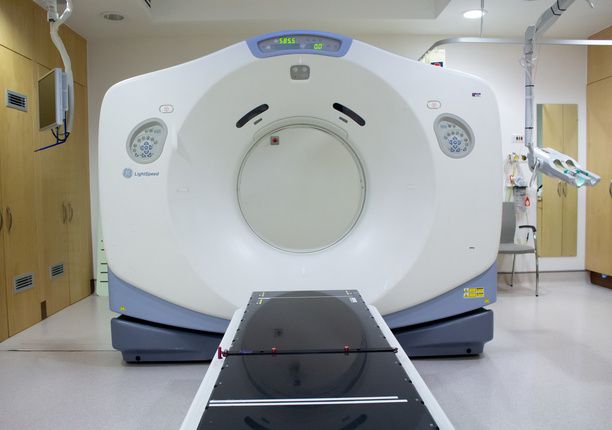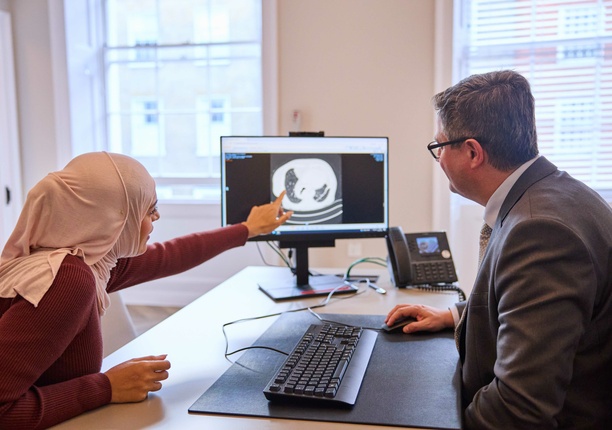PET-CT scans
Positron emission tomography (PET) and computed tomography (CT) scans are advanced imaging techniques used to look for disease, inflammation or infection in your body.
At The London Clinic Lung Centre, we use a state-of-the-art system which integrates PET and CT technologies for precise imaging and unparalleled diagnostic accuracy.
What are PET-CT scans?
Our PET-CT scan service combines Positron emission tomography (PET) and computed tomography (CT) to produce highly detailed, 3D images of the inside of your body. This advanced diagnostic tool enables early and accurate detection of conditions such as lung cancer. It also helps us to stage cancers, evaluate treatment responses and diagnose other complex conditions.
Positron emission tomography (PET) identifies physiological changes in your body. For example, a PET scan can be used in a confirmed case of lung cancer to determine the extent of cancer spread and assess whether it is responding to treatment.
Before a PET scan, a radioactive drug called a tracer, is injected into a vein. This tracer accumulates in areas of your body with higher levels of metabolic or biochemical activity, helping to highlight the location of a disease. For instance, bright spots on PET scans may indicate cancerous cells, as they have a higher metabolic rate than non-cancerous cells.
Computed tomography (CT) provides a highly detailed image of your body’s structure. It is usually used to diagnose conditions, such as cancer. For example, it can show where a tumour is, how big it is and monitor its size throughout treatment.
Together, PET scans provide functional information, while CT scans offer anatomical details. By combining the two scans, we can obtain even more precise imagery – allowing for accurate and clear visualisation of the scanned areas.
Are there any risks associated with PET-CT scans?
The radioactive tracer injected into your vein for a PET scan will expose you to a small amount of radiation, but there are no immediate side effects of this. The amount of radioactivity is relatively low, with a half-life of 110 minutes, and most of it is passed out through the kidneys. As a result, the risk of negative effects from the radiation is minimal. However, having repeated PET-CT scans can very slightly increase your lifetime cancer risk.
Once the scan is complete, you will remain radioactive for six hours. We advise you to avoid contact with young children and pregnant women for four hours after leaving the department. The test is not advised if you are pregnant or breastfeeding.
Low-dose CT screening FAQs
Once your scan is complete, a radiologist, who is trained to interpret scan images, will analyse the results and share them with your consultant. Your consultant will then report the findings back to you within 24 hours and discuss potential treatment options.
Depending on the indications for performing your test, the scan will take between 20 and 45 minutes. You should allow approximately 2.5 hours for the entire appointment.
Step 1. Preparing for your PET-CT scan
Prior to your PET-CT scan, you will be given instructions on how to prepare. Here’s an example of what to expect:
- Fasting – avoid eating, drinking (except water) and chewing gum or mints for at least six hours before the scan, as these may affect the accuracy of the metabolic imaging
- Hydration – drink plenty of water before the scan, unless instructed otherwise
- Medication – inform your care team about any medications you are taking, as some may need to be adjusted before the scan. If you have diabetes, you will receive specific instructions on managing your blood sugar levels beforehand
- Physical activity – refrain from strenuous exercise for 24 hours prior to the scan, as this can impact the uptake of the tracer in your muscles
- Clothing – you should not wear any form of metal while in the scanner, so be sure to remove jewellery, watches or other metal accessories. Wear loose, comfortable clothing without metal components like buttons or zippers
- Health conditions – inform your care team if you are pregnant, breastfeeding or have recently had any illnesses or surgeries
Just before you have your scan, a technologist will explain the procedure, give you an opportunity to ask any questions and go through a checklist of questions with you.
Step 2. During your PET-CT scan
An hour before your scheduled scan, a technologist will inject the tracer into a small vein in your arm. The injection will not make you feel any different or cause any side effects.
You will then need to wait for one hour in our comfortable PET-CT uptake room. During this time, it is important that you are as relaxed and warm as possible. You will not be able to read, listen to music or wait with a relative, friend or carer. If this will not be possible for you, please inform the department before your test so we can make any necessary accommodations.
After the hour, we will ask you to lie on your back on the scanning table inside the PET-CT machine. The machine is round, with a tunnel in the middle, resembling a doughnut. The scanning table slides into the tunnel. You will need to lie very still during the scan. However, you will be able to communicate with the technologist through an intercom throughout the procedure. They may ask you to briefly hold your breath to help you stay still during certain parts of the test. This will help to ensure the images produced are clear.
The test will not hurt. However, if you’re afraid of enclosed spaces, you may feel some anxiety. If you inform us that you struggle with anxiety in enclosed spaces prior to your test, we may be able to give you some medication to help you relax.
Step 3. Recovery and aftercare
After the test, the technologist will check the quality of the scan and let you know when you are free to leave. You will then be able to carry on with your day as usual unless your provider advises otherwise. You will need to drink plenty of fluids to help flush the tracer from your body.







